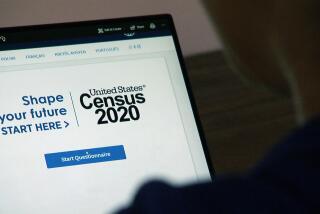Census’ Multiracial Option Overturns Traditional Views
- Share via
Someday, when race is more negotiable--more someone’s description of his mood than his identity--historians may say it started with Census 2000.
This census, due for release as early as this week, is the first in which Americans were invited to mark one or more races, creating a total of 57 new categories with anywhere from two to six races, such as white-Asian or black-Latino-American Indian.
Experts estimate that only about 4% of Americans identified themselves as multiracial in 2000, but the implications are stunning. The census’ formalizing of multiple-race answers undermines more than 200 years of law and tradition and explodes the most basic notion of race: that there are discrete bio-cultural groups of human beings.
The ensuing debate could overshadow the census’ traditional function of establishing the numbers upon which political reapportionment, federal revenue allotments and mass marketing are based.
“Once you have opened up the census in this revolutionary fashion there’s really no natural limit, no natural boundaries between the races,” said Kenneth Prewitt, the director of the U.S. Census Bureau until he stepped down earlier this year.
The multiracial movement in America has been growing for years, reflecting vast demographic shifts over the past four decades that belied traditional racial categories. In the 1990 census, the third-fastest-growing category was “Other,” with 2 million people. Those statistics galvanized multiracial lobbying efforts.
“It just became impossible to deny that people have origins in more than one race,” said social historian Joel Perlmann.
But the multiple-race census was opposed by groups like the NAACP and the Japanese Citizens League, who have argued that the destabilization of racial categories could weaken civil rights enforcement efforts.
The greatest impact of Census 2000 will be felt at the local level, especially in states and cities that have diverse and well-integrated communities. A Princeton University study found that multiracial residents represent 8% of Hawaii’s population and 10% in Oklahoma, where there are large numbers of multiracial American Indians.
A 1999 census survey of some 14 million Americans found the proportion of residents who checked more than one race was 3.3% in San Francisco, 3.8% in New York’s Bronx borough and 4.5% in Yakima, Wash. In a Census Bureau “dress rehearsal” for 2000 conducted in Sacramento, 5.4% said they were multiracial; in some tracts, they represented 11% of the population.
Ethnic groups with higher rates of intermarriage--Asians, Native Hawaiians and Native Americans--are expected to be particularly affected.
Drawing a clear picture from the race data is further complicated by the “ethnicity” question. In 1980, the census added a question that asked whether respondents were Latino. That layer creates twice as many multiracial and ethnic categories.
Constructing Ethnicity
The census has always played a dominant role in defining ethnicities. In its inception, in 1790, it held that a black slave was literally a fraction of a white man. In the early 19th century, Irish immigrants were considered to be “Negroes.” The government used the term “Hispanic” to include huge swaths of multiracial humanity, first on an ancestral origin question in 1970 and then as a question of ethnicity in 1980.
Race is a social construct, but it has real economic, political and social effects. Multiple-race census data seem likely to make it harder to quantify those effects. Beyond the census, the data are about to filter into many other social-policy arenas.
The White House Office of Management and Budget has instructed more than 60 federal agencies to incorporate multiple-race information by 2003. Policymakers say this new way of collecting racial information will gradually trickle down from agencies such as the Center for Disease Control and Prevention and the National Center for Educational Statistics to state governments, city agencies and even individual schools, police stations and private businesses.
Some researchers at federal agencies, universities and think tanks throughout the nation say multiracial data collection has launched the country into uncharted regions where politics, identity, law and culture will collide with confusing effects.
“We’re definitely opening up a whole set of new issues, and I’m not sure where it’s going to go,” said Brookings Institution researcher Peter Skerry. “We may not just have battles between races, but battles about race itself.”
Even the pure statistical questions will be daunting. For example, federal statisticians tracking the prevalence of liver disease among American Indian communities will have single-race data until 1990. Then they will have to make sense of data from 2000, in which significant numbers of American Indians will check an additional race.
The Office of Management and Budget has outlined several tactics for its agencies to make sense of this. They include assigning multiple-race responses to single-race categories and recording multiracial people as racial fractions. (A black and Asian woman might be counted as one-half of a black person and one-half of an Asian person.) These statistical strategies will vary widely, depending on the agency and the source of the data.
If the numbers are calculated imprecisely--something many demographers say is inevitable with multiracial data--it could create illusory problems or obscure real challenges.
Take the fact that so many Americans claim some degree of American Indian heritage. “With the new standards you could have a tripling of the Native American population,” said Matthew Snipp, a Stanford University professor and a member of the Census Bureau’s Advisory Committee on American Indians and Alaska Natives. “So for programs that are based on some minimum population number, you’ve got more Indians to serve. On the other hand, they might be better educated or have higher incomes.” It would be up to statisticians to determine whether those higher populations and incomes are because of error, or to real gains.
“I look on this as a demographer’s full-employment act,” said Snipp.
Federal Law Based on 6 Races
Foremost on the minds of many sociologists and civil-rights activists, however, is the way multiracial data will complicate anti-discrimination monitoring and enforcement, the primary purpose of federal data on race.
School desegregation plans and regulatory programs for housing, employment, health and the environment all use racial statistics to some degree. Right now, federal civil-rights law recognizes only six mutually exclusive racial and ethnic categories: “American Indian or Alaska Native,” “Asian,” “Black or African American,” “Hispanic or Latino,” “Native Hawaiian or Other Pacific Islander” and “White.” So how will someone is black and white, or Asian and American Indian, or Asian and white and Native American and Pacific Islander be collapsed into the pertinent single-race categories?
It depends.
Multiracial people who indicate they are white and something else will generally be “allocated to the minority race,” according to guidance from the Office of Management and Budget. When responses combine two or more minority races, the federal standards state that the situation will be resolved on a case-by-case basis.
If a mixed-race person makes a discrimination complaint, that person will be allocated to the race he thinks the discrimination was based on. For example, if a man who is black and Asian American believed he was denied a job at a grocery store because the manager thought he was black, the Equal Employment Opportunity Commission could list that individual as black, regardless of his Asian American heritage.
Reinterpreting Multiculturalism
Matt Kelley, the founder of a Seattle-based magazine about interracial issues, says the notion of the government interpreting multiracial categories in civil-rights enforcement subverts the principle of multiculturalism.
“All of a sudden to finally be given the opportunity to choose more than one race, and then seemingly have that taken away seems a little suspect,” said Kelley, who is Korean American and white. “Besides it would be wrong to say that I would only be discriminated against because I am Korean or Asian American. I used to bus tables, and people used to think I was Mexican.
“The reality is that I might be discriminated against because someone thinks I am Native American or Latino or Asian American,” said Kelley, who has been taken for all three races. “And sometimes people are discriminating against others just because they are multiracial--not because they are perceived to be one thing or another.”
Things get even more complicated if an enforcement action requires a statistical sample. Suppose the government wanted to find out if a grocery store chain was guilty of a discriminatory “pattern and practice” of not hiring a particular racial group. The agency might survey the business’ racial make-up and allocate each multiracial individual to one of the six major racial groups. Then the government would compare those findings to the demographics of the surrounding area, again allocating all multiracial responses. Critics find that scenario hopelessly subjective.
“So if you’re talking about racial profiling in terms of census data,” said former census director Prewitt, “and you want to know how many blacks were picked up driving in New Jersey compared to the total black population of New Jersey, we’re going to be arguing about who is and isn’t black.”
Determining Voting Violations
One of the hottest flash points for multiracial data may be the issue of voting rights and reapportionment. The Voting Rights Act of 1965 prohibits the drawing of voting districts to purposefully split or dilute minorities’ votes.
In the past, racial statistics collected by the census and other agencies were used to determine voting rights violations. But now it will become trickier. Take a county supervisor’s district where 40% of residents marked African American as their only race and an additional 15% marked black plus another race. Is this a majority black district? Some experts predict this question will be among the first census issues to reach the Supreme Court.
The multiracial guidelines for federal agencies are only “provisional” and could change depending on what the census data show. Since the guidelines were issued during the Clinton administration, the Bush administration might wish to alter them, though the president has given no indication that the issue is on his radar. Public hearings on the guidelines are ongoing and new studies by the Census Bureau, the Department of Labor and the Department of Health are aimed at determining why census respondents chose the races they did, and whether the racial allocation standards could be improved. Also still undecided is how the government will deal with multiracial data when it comes to eligibility for targeted programs, like the Small Business Administration’s loans for minority businesses.
“This is still an evolving piece of guidance,” said Katherine K. Wallman, chief statistician of the Office of Management and Budget. “In fact my copy of the standards is still in a loose-leaf notebook.”
(BEGIN TEXT OF INFOBOX / INFOGRAPHIC)
A New View of Race
When the first wave of data from the 2000 census is released later this month, it will reflect 57 new multiracial categories. For the first time, the census allowed Americans to check more than one of the six traditional racial categories, shown in white. That resulted in the creation of the following choices on the census questionnaire
More to Read
Sign up for Essential California
The most important California stories and recommendations in your inbox every morning.
You may occasionally receive promotional content from the Los Angeles Times.













